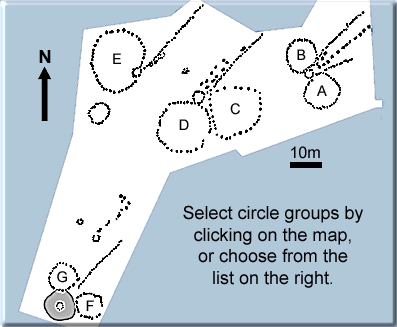
 |
|
Virtual Beaghmore |
|
|
Circles A & B |
|
|
|
Circles C & D |
|
|
|
Circle E |
|
|
|
Circles F & G |
The area around the Sperrins Mountains in counties Fermanagh, Londonderry and Tyrone is home to a concentration of distinctive sites comprised of multiple stone circles associated with cairns and stone rows. The rings here are of small diameter and the stones themselves are diminutive, most struggling to achieve knee height. As if to compensate for the small size, the rings are comprised of numerous, almost contiguous stones, a count of over forty being usual. The rings are nearly always misshapen, and frequently occur in paired or multiple arrangements, stone rows leading to cairns are also common features. Of the three counties mentioned above, Tyrone is the focus for these monuments, with 80% of its 61 known circles occurring in paired or multiple arrangements, but its most famous example must be the stone circle and row complex at Beaghmore.
Beaghmore, "the moor of the birches", was first uncovered in 1945-9 when 1269 stones were uncovered, they had been buried in the thick layer of peat that is a dominating feature of this area. Further work in 1965 revealed more of the complex, although it is almost certain that further structures still lie buried in the surrounding peat. A total of seven circles, six of which are paired, were discovered, along with many cairns, some of which have associated stone rows. A typical feature of the Beaghmore stone rows is a "high and low" arrangement where short rows of tall stones run beside much longer rows of small stones. The rows may show rough alignments to the midwinter sunset at the SW, although an horizon raised 3 degrees or so by a nearby tree line would be necessary for these alignments to be valid.
The circles and rows we see at the site today are thought to date from about 1600 BC, the early Bronze Age, but they are not the earliest evidence of usage of the site. Hearths and deposits of flint tools were discovered and have been carbon dated to 2900-2600BC, in addition, several of the stone rows run over the tumbled walls of field structures which also date from the Neolithic period.